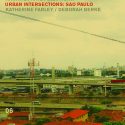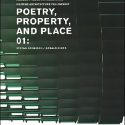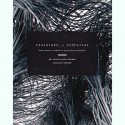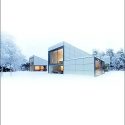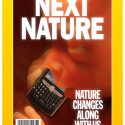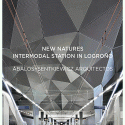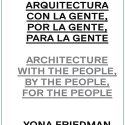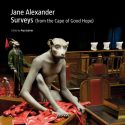Your Cart is empty
Urban Intersections: Säo Paulo
Edward P. Bass Distinguished Visiting Architecture Fellowship 06
Nina Rappaport, Noah Biklen, Eliza Higgins
Urban Intersections: Sao Paolo documents the collaboration of Edward P. Bass Fellow Katherine Farley, senior managing director of the international real estate developer Tishman-Speyer and Yale adjunct professor Deborah Berke, assisted by Noah Biklen, at the Yale School of Architecture. The book features ways to examine the process of urban design and development in Sao Paolo, Brazil, a rapidly growing global mega-city, with all its attendant vitality and contradictions. The work engages both the development issues of schedule, phasing, risk, sustainability, value, and density along with the architectural issues of scale, formal clarity, envelope articulation, use of color and texture, and the relationship of building to landscape. An essay by Victoria Grossman analyzes and critiques development in Sao Paolo.
Poetry, Property, and Place, 01
Nina Rappaport
Stefan Behnisch / Gerald Hines
Architect Stefan Behnisch and developer Gerald Hines in a Yale advanced studio, had students design projects to transform Garibaldi Repubblica, a neglected site in central Milan, into a vital urban place.
Paradigms in Computing
Making, Machines, and Models for Design Agency in Architecture David Jason Gerber, Â Mariana Ibañez
Paradigms in Computing: Making, Machines, and Models for Design Agency in Architecture brings together critical, theoretical, and practical research and design that illustrates the plurality of computing approaches within the broad spectrum of design and mediated practices. It is an interrogation of our primary field of architecture through the lens of computing, and yet one that realizes a productive expanding of our definition and boundaries. It is a compilation that purposefully promotes architectures disciplinary reach and incorporations beyond the design and construction of buildings and cities. The book offers a glimpse into the wide range of positions and experiences that are shaping practice and discourse today. The work included in Paradigms in Computing is evidence that models for enquiry are many and proliferating. As digitalization and computation continue to infuse our processes with new tools and new design environments, some of the trends collected in this book will continue to be central to the production and speculation of architecture, and others will, multiple, paradigms.OAB Ferrater and Partners (ENG ED.)
Recent architectural projects by Carlos Ferrater and his Office of Architecture Barcelona (OAB)
Carlos Ferrater, Borja Ferrater
With the publication of the book Synchronizing Geometry, in 2006 the baseline of a typical OAB theoretical discourse was established in which a series of projects under development or construction stressed the importance of a theoretical background in the professional practice of architecture. A few years later, this book arrives showing the work carried out and now going into more depth on the direction and approach of Ferrater / OAB. It also analyses and reflects on the career of Carlos Ferrater, as well as the results of the development of a new office involving a group of young architects, including family members. The book explains how from experience and the examination and manipulation of some complex geometries a critical and theoretical vision of reality is established, assuming at all times rigour, social roots, landscape and construction. For this reason, the book also reveals how the activity of OAB is not only developed in the execution of construction projects, but how it is also complemented and enriched by going into depth in other fields such as teaching and academic research. This book illustrates how, from over 35 years experience on Carlos Ferrater's part, and the emergence and participation of a group of young architects ( such as Xavier Martí, Lucia and Borja Ferrater, Nuria Ayala, Alberto Peña etc. ), a new concept of professional office has taken shape.
Buy Spanish edition
Next Nature
Nature Changes Along with Us. Exploring human impact on nature
Koert van Mensvoort, Hendrik-Jan Grievink
Today the human impact on our planet can hardly be underestimated. Climate change, population explosion, genetic manipulation, digital networks, plastic islands floating in the oceans. This book explores our changing notion of nature. How nature has become one of the most successful products of our time, much of what we perceive as nature is merely a simulation although a romanticized idea of a balanced, harmonic, inherently good and threatened entity. How evolution continues nonetheless. How technology - traditionally created to protect us from the forces of nature - gives rise to a next nature, that is just as wild, cruel, unpredictable and threatening as ever. How we are playing with fire again and again. How we should be careful in doing so, yet how this is also what makes us human.
Will we be able to improve our human condition, or will we outsource ourselves for good People are catalysts of evolution, yet we are only beginning to get attuned with this job description. At least we can be certain of one thing: we will get the nature we deserve. Hence the need to explore how we can design, build and live in the nature caused by people.
New Natures
Intermodal Station in Logroño
Inma E. Maluenda
Ábalos Sentkiewicz arquitectos
Monograph dedicated to the new Intermodal Station Logroño, Spain by Iñaki Abalos and Renata Sentkiewicz, tells how the authors started from the intention to exploit the underground of the tracks and the train station to create a memorable urban event. Under a single encompassing gesture, it doesn't only contribute functional benefits to the city of Logroño (a new high-speed railway and bus station), but specially allows to create a large pedestrian space, a park or artificial hill, culminating with uninterrupted pursuit of a new urban green ring where the tracks would separate the city in two. Among its contents, the book also includes an unpublished article by Stan Allen, interview with the editors, I. E. Maluenda and E. Encabo to Abalos and Senkiewicz, some specialized essays by T. Gala-Izard and M. C. Gutierrez as well as the photography by Jose Hevia of both the construction process and the finished project in its first phase.
Spanish edition
Mies Van der Rohe Award 2011
European Union, price for Contemporary Architecture
This biennial prize is conceded by the European Union and organized by the Mies van der Rohe Foundation in Barcelona to recognize and reward the quality of the architectural production in Europe. Candidates are nominated by a diverse group of independent experts from all over Europe. In each edition, the jury awards two prizes: the European Community Prize for Contemporary Architecture, presented for conceptual, technical and con-structive qualities of a project, and the Special Mention for Emerging Architect. The Mies van der Rohe Pavilion in Barcelona incarnates the main objectives that the prize looks for: excellence and innovation in conceptual and constructive terms. The 2011 edition of the biannual publication that accompanies the prize will present the winning project and also the six finalists: the New Museum (Berlin, Germany) by David Chipperfield Architects; the Bronks Theatre (Brussels, Belgium) by MDMA; the MAXXI: Museum of 21st Century Arts (Rome, Italy) by Zaha Hadid Architects; the Danish Radio Concert Hall (Copenhagen, Denmark) by Ateliers Jean Nouvel; the Acropolis Museum (Athens, Greece) by Bernard Tschumi Architects; and the Rehab Center Groot Klimmendaal (Arnhem, The Netherlands) by Architectenbureau Koen van Velsen.
Architecture with the People, by the People, for the People
Yona Friedman
This monograph, second in the collection featuring artists and architects who maintain a critical view of the contemporary world, is devoted to the distinguished Hungarian architect, living and working in Paris, Yona Friedman. Yona Friedman's work spans urban models, theoretical texts and animated films. He has participated in several biennial art exhibitions, including Shanghai, Venice and Documenta 11. His visionary, ground-break-ing ideas have been at the forefront for several generations of architects and urban planners, and have clearly influenced the likes of Kenzo Tange, Arata Isozaki or Bernard Tschumi.
While Friedman is still active and remains socially committed, his most important ideas stem from the fifties and sixties. In 1956, he published his Manifeste de l'architecture Mobile, which set an urban structure on piles suitable for areas where building had not been not possible. This text was in turn used as the founding document of the Groupe d'architecture mobile (GEAM). He developed urban concepts such as the Spatial City where dwellings are freely distributed by the citizens thanks to low-cost, reusable mobile models. In 1965, along with Ionel Schein, Walter Jonas and others, he founded the Groupe International d'Architecture Prospective (GIAP).
See Preview on issuu
Jane Alexander
Surveys from the Cape of Good Hope
Pep Subirós
Jane Alexander is one of the most significant African contemporary artists working today. Her animal-human sculptures, photographs, and dramatic installations speak of lasting disfigurations in her native South Africa, yet raise issues about human nature that resonate with viewers internationally. Alexander's hybrid mutants inhabit a universe where boundaries between self and other, human and animal, are unstable, where shared foundations and clashing differences are disclosed, and where the grotesque and the familiar entwine. While the figures are, in many ways, emblems of monstrosity, they are oddly beautiful. Her creatures expose the human animal for all it is and all it could become. Not only are Alexander's artworks formally and technically accomplished, but they also deliver a potent emotional impact, sending warnings about historical consequences and hinting at things to come.


